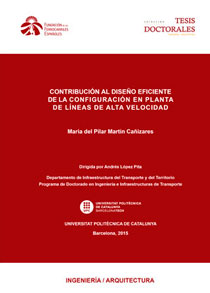
Categories
Publications
Contribution to the efficient design of track layout of high-speed lines

Building a high-speed line requires significant investment and its design strongly influences the operation, with the aggravating circumstance that subsequent modifications not initially planned are not always feasible at a reasonable cost. It is therefore necessary to define an optimal infrastructure configuration.
This thesis identifies two dimensions which should be considered when designing a new high-speed line:
- Time dimension: capacity requirements are not constant throughout the life cycle of the infrastructure. Usually there is an upward trend but subject to many uncertainties. Therefore, the time dimension involves the study of scalable design so that offered capacity adapts to demand, thus mitigating the risk of any cost overrun.
- Spatial dimension: not all lines and even not all sections of a line have the same functionality in a railway network. Traffic patterns, demand volumes and speed requirements differ from one section to another, and therefore the equipment must also be different and adapted to the particular conditions. Moreover, sometimes a new high-speed line is planned to link populations that hitherto had conventional line to reduce travel times. In such cases, a decision will have to be taken on what to do with the existing line. Both issues are included in the spatial dimension.
The aim of this thesis is to undertake a systematic and comprehensive analysis considering both dimensions and addressing in detail technical and economic aspects to finally present the Two-dimensional design methodology for high-speed lines as a tool to achieve their efficient design. Efficient design is defined as that which guarantees the availability, robustness and level of service suitable for an acceptable cost, not only under normal operating conditions but also in degraded states. The analysis is confined to the track layout of new high-speed lines.
On the basis of a detailed analysis of the high-speed networks in Japan, France and Spain, it is possible to identify existing design patterns and determine the structure and topology of the networks and how these influence operation and traffic flows that can occur on them.
Download book (pdf - free) »


